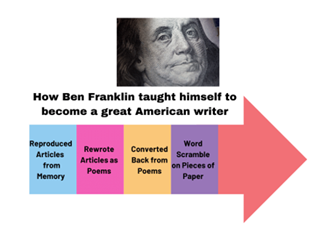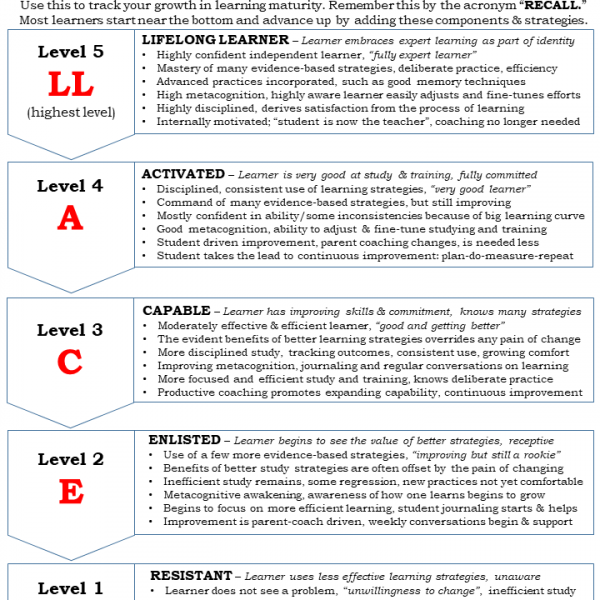
Ben Franklin Case Study – Instructor’s Guide

This is your instructor’s guide – use it with Ben Franklin Case Study Reading. It will help you lead a lesson with your children on studying smarter and it can open the door for subsequent productive conversations on using the powerful learning method of deliberate practice.
The steps for preparing for this lesson are easy.
- Download and print a copy of the Case Study Reading for each of you.
- Read the case study before you teach it and familiarize yourself with the four learning strategies of Ben Franklin.
- Read this Instructor’s Guide and get familiar with the Key Ideas and the Discussion Questions. Decide which ones you want to use to stimulate thought-provoking discussions during your lesson.
That’s it. You will be ready to talk about Ben Franklin and how he became a great writer through deliberate practice!
A. Review the Key Ideas
First read and review the components of this true story and note the learning strategies he used. The following are key ideas of deliberate practice you should share and use to talk about improving your study efforts:
- First, Ben did what smart learners do – he identified the known “experts” in his field of interest. He observed their work and used it to guide his training. This is always where you should begin – set a training plan by mimicking what expert performers do. For example, if your son or daughter is trying to become a much better soccer player, study how college-level or professional players train.
- He identified the important subset skills of effective writers and designed activities to practice each of these skills. To plan your learning efforts, break it down – list all of the important skills your child will need to learn or master. Many people can’t find breakthroughs because they fail to develop a complete set of skills necessary to become an expert performer.
- He created different training strategies to keep pushing himself, much like the weightlifter gradually increasing weights when resistance training, or the runner who strives to shorten her lap times. He did not allow himself to get comfortable, as he knew this might cause him to plateau, and his goal was not to get slightly better! This is part of the concept of desirable difficulties. This is the heart of your lesson – study and train in a way that you keep yourself slightly outside your comfort zone.
- He wisely did not keep repeating the same study strategies over and over, he improved and varied them to continually keep himself challenged. We now know this as the powerful learning strategy of interleaving. Learn more about this in our free parent resources or our online course Improving Your Child’s Learning Power.
- His study methods benefited from frequent feedback where he used the articles written by the experts to compare his work and improve his efforts. Without feedback, you may think you are getting better when you aren’t. (This is called the illusion of learning.) Help your child study better by encouraging them to set up their own personalized feedback system through frequent self-quizzes, retrieval practice, and recitation. And by getting help from you as a coach.
- He continually experimented with different approaches as he assessed his learning progress. He was willing to change his training as he uncovered deficiencies. This is important – many students treat the discovery of learning gaps as bad news, and something to be avoided. Coach your child to develop a more positive growth mindset where finding gaps in knowledge is seen as a good thing and an important part of developing knowledge and expertise.
B. Lead the Lesson
This lesson is appropriate for most ages but works best with those who have independent study or are training to learn something difficult that requires frequent practice, such as playing a musical instrument, learning a second language, or practicing a sport. Kids who have study routines they can examine will relate best to it. Kids who have plateaued in learning might find it motivating because it may help them find breakthroughs.
The point of this lesson is to teach your child the concept of deliberate practice. Ben Franklin provides a great example to inspire young people to study smarter. Think of this lesson as a door opener to more conversations on how to study smarter.
Steps
| Introduce the topic – You can do this by reading the first page of the case to your kids. State that you have some good ideas that all of you can use to learn better. We all can learn how to learn better!
|
5 min |
| Read page 3 together – This introduces your lesson. Feel free to add your own material for more background on Ben Franklin, or conduct a short review of ideas you have already taught about him. Tying new material to things we already know helps us learn better.
|
5 min |
| Read each of the 4 learning strategies one at a time. Talk about the reason he was doing that strategy and what skills he hoped to improve. Summarize the main idea for each by reviewing the commentary. Promote deeper thinking by asking the question at the bottom of the page.
|
5-10 min each |
| After covering the 4 strategies, you want to process this information so your kids can start thinking about deliberate practice and how they might use it. You have two groups of questions you can choose from to do this. The Summary Questions on page 8 of the case provide a useful start to your discussion, you might find several from it that you want to use.
|
5 min |
| Take a short break
|
5 min |
| Use the Case Discussion Questions on pages 4 and 5 of this guide to review the key ideas from this case. Again, pick and choose the questions you think might generate the best discussions.
|
5-15 min |
| Close with an affirmation that you want to incorporate deliberate practice into more of your study routines at home. | 2 min |
C. Case Discussion Questions
These questions will help you turn this case into a lesson. Use Ben’s steps to begin a conversation on how your child can study smarter by creating his or her version of desirable difficulties. Then apply the ideas to something your child is trying to learn:

- From this reading, we know Ben Franklin became one of America’s greatest writers. Why did he have to teach himself how to become a better writer?
- You learned a two-word term we use to describe what you are trying to do when you make your studies a little bit harder so you can learn faster? What is it?
- Ben Franklin could have chosen to practice by only reproducing articles from The Spectator. Instead, he adjust his learning practices and began writing poems from the articles. Why?
- In step one, after Ben Franklin read the Spectator articles, he waited a few days, so he forgot the details before trying to reproduce them. Why did he do this? How did this help him to learn better?
- In step two, he took more Spectator articles and, instead of rewriting them, he now rewrote them as Why do you think he did this? How did writing poems help him to learn?
- In step three, he took his verse and rewrote it to convert it back into an article, again without looking at the original. What skill did this help him develop?
- In step four, he took more Spectator articles and created his version of a “word scramble.” He wrote key words on small papers then scrambled them, carefully put them back together in order, then wrote an entirely new article using this as a guide. What new skill did this help him practice here?
- What can we learn from Ben Franklin? How can we apply some of these ideas at home with your studies?
- Let’s identify one thing that you really want to learn to do well. What can you do differently in this to adopt the ideas from deliberate practice? How can you make it just a little more difficult for your brain? Let’s find one thing we can change so you can study like Ben Franklin!
- What is a polymath? Name some famous historical men and women who were polymaths. (if you can’t think of some, make this a research mini-project.)
For more information on deliberate practice, sign up for our online course Improving Your Child’s Learning Power where you will learn how to use an entire toolbox of ideas and mini-lessons on better learning.






